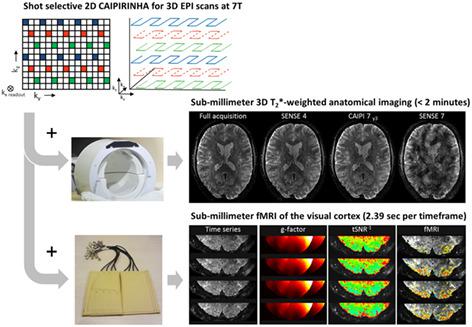当前位置:
X-MOL 学术
›
NMR Biomed.
›
论文详情
Our official English website, www.x-mol.net, welcomes your feedback! (Note: you will need to create a separate account there.)
Pushing functional MRI spatial and temporal resolution further: High-density receive arrays combined with shot-selective 2D CAIPIRINHA for 3D echo-planar imaging at 7 T.
NMR in Biomedicine ( IF 2.9 ) Pub Date : 2020-03-03 , DOI: 10.1002/nbm.4281 Arjan D Hendriks 1 , Federico D'Agata 1, 2 , Luisa Raimondo 1, 3 , Tim Schakel 1 , Liesbeth Geerts 4 , Peter R Luijten 1 , Dennis W J Klomp 1 , Natalia Petridou 1
NMR in Biomedicine ( IF 2.9 ) Pub Date : 2020-03-03 , DOI: 10.1002/nbm.4281 Arjan D Hendriks 1 , Federico D'Agata 1, 2 , Luisa Raimondo 1, 3 , Tim Schakel 1 , Liesbeth Geerts 4 , Peter R Luijten 1 , Dennis W J Klomp 1 , Natalia Petridou 1
Affiliation

|
To be able to examine dynamic and detailed brain functions, the spatial and temporal resolution of 7 T MRI needs to improve. In this study, it was investigated whether submillimeter multishot 3D EPI fMRI scans, acquired with high-density receive arrays, can benefit from a 2D CAIPIRINHA sampling pattern, in terms of noise amplification (g-factor), temporal SNR and fMRI sensitivity. High-density receive arrays were combined with a shot-selective 2D CAIPIRINHA implementation for multishot 3D EPI sequences at 7 T. In this implementation, in contrast to conventional inclusion of extra kz gradient blips, specific EPI shots are left out to create a CAIPIRINHA shift and reduction of scan time. First, the implementation of the CAIPIRINHA sequence was evaluated with a standard receive setup by acquiring submillimeter whole brain T2 *-weighted anatomy images. Second, the CAIPIRINHA sequence was combined with high-density receive arrays to push the temporal resolution of submillimeter 3D EPI fMRI scans of the visual cortex. Results show that the shot-selective 2D CAIPIRINHA sequence enables a reduction in scan time for 0.5 mm isotropic 3D EPI T2 *-weighted anatomy scans by a factor of 4 compared with earlier reports. The use of the 2D CAIPIRINHA implementation in combination with high-density receive arrays, enhances the image quality of submillimeter 3D EPI scans of the visual cortex at high acceleration as compared to conventional SENSE. Both the g-factor and temporal SNR improved, resulting in a method that is more sensitive to the fMRI signal. Using this method, it is possible to acquire submillimeter single volume 3D EPI scans of the visual cortex in a subsecond timeframe. Overall, high-density receive arrays in combination with shot-selective 2D CAIPIRINHA for 3D EPI scans prove to be valuable for reducing the scan time of submillimeter MRI acquisitions.
中文翻译:

进一步推动功能性MRI的时空分辨率:高密度接收阵列与镜头选择性2D CAIPIRINHA相结合,可在7 T时进行3D回波平面成像。
为了能够检查动态和详细的大脑功能,需要改进7 T MRI的时空分辨率。在这项研究中,研究了用高密度接收阵列采集的亚毫米多镜头3D EPI fMRI扫描是否可以从2D CAIPIRINHA采样模式中受益,包括噪声放大率(g因子),时间SNR和fMRI灵敏度。高密度接收阵列与镜头选择性2D CAIPIRINHA实现方案相结合,可实现7 T时的多镜头3D EPI序列。在这种实现方案中,与常规包含额外的kz梯度尖峰相比,特定的EPI镜头被遗漏以产生CAIPIRINHA偏移并减少扫描时间。首先,通过获取亚毫米级全脑T2 *加权解剖图像,以标准的接收设置评估了CAIPIRINHA序列的实现。其次,将CAIPIRINHA序列与高密度接收阵列相结合,以推动视觉皮层的亚毫米3D EPI fMRI扫描的时间分辨率。结果表明,与早期报道相比,选择击球的2D CAIPIRINHA序列可使0.5 mm各向同性3D EPI T2 *加权解剖扫描的扫描时间减少4倍。与传统的SENSE相比,将2D CAIPIRINHA实现与高密度接收阵列结合使用可提高视觉皮层的亚毫米3D EPI扫描图像的图像质量。g因子和时间SNR均得到改善,从而导致对fMRI信号更加敏感的方法。使用此方法,可以在亚秒级的时间内获取视觉皮层的亚毫米单体积3D EPI扫描。总体,
更新日期:2020-04-22
中文翻译:

进一步推动功能性MRI的时空分辨率:高密度接收阵列与镜头选择性2D CAIPIRINHA相结合,可在7 T时进行3D回波平面成像。
为了能够检查动态和详细的大脑功能,需要改进7 T MRI的时空分辨率。在这项研究中,研究了用高密度接收阵列采集的亚毫米多镜头3D EPI fMRI扫描是否可以从2D CAIPIRINHA采样模式中受益,包括噪声放大率(g因子),时间SNR和fMRI灵敏度。高密度接收阵列与镜头选择性2D CAIPIRINHA实现方案相结合,可实现7 T时的多镜头3D EPI序列。在这种实现方案中,与常规包含额外的kz梯度尖峰相比,特定的EPI镜头被遗漏以产生CAIPIRINHA偏移并减少扫描时间。首先,通过获取亚毫米级全脑T2 *加权解剖图像,以标准的接收设置评估了CAIPIRINHA序列的实现。其次,将CAIPIRINHA序列与高密度接收阵列相结合,以推动视觉皮层的亚毫米3D EPI fMRI扫描的时间分辨率。结果表明,与早期报道相比,选择击球的2D CAIPIRINHA序列可使0.5 mm各向同性3D EPI T2 *加权解剖扫描的扫描时间减少4倍。与传统的SENSE相比,将2D CAIPIRINHA实现与高密度接收阵列结合使用可提高视觉皮层的亚毫米3D EPI扫描图像的图像质量。g因子和时间SNR均得到改善,从而导致对fMRI信号更加敏感的方法。使用此方法,可以在亚秒级的时间内获取视觉皮层的亚毫米单体积3D EPI扫描。总体,


























 京公网安备 11010802027423号
京公网安备 11010802027423号